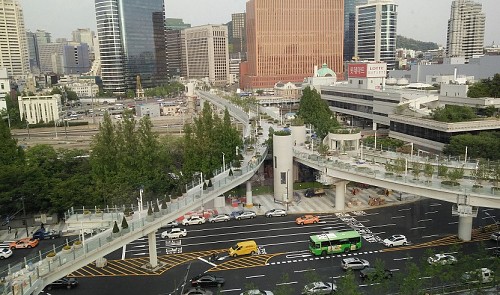The Seoullo 7017 project, set to be completed this month by the Seoul Metropolitan government, features a dilapidated overpass in the South Korean capital that has been transformed into a large-scale pedestrian street and essential tourist attraction.
Once an elevated road reserved just for cars, the degraded concrete structure is now being turned into an exclusive area for local residents and tourists to take in some local culture.
Prior to the official opening of the pedestrian road, slated for May 20, a group of international reporters were invited on a press tour to learn more about the project.
Eighteen journalists representing media from six countries, including Vietnam’s Tuoi Tre (Youth) newspaper, were the first foreign press to set foot on the new footpath.
Built in 1970, the Seoul Station overpass was originally a symbol of the rapid modernization underway in the South Korean capital.
As the structure became dilapidated and unsuitable for an increasingly pedestrian-friendly Seoul, local authorities decided in 2015 to recycle the road rather than destroy it.
A design competition for the project was carried out shortly after in which Dutch architect Winy Maas submitted a plan for the old Seoul Station overpass to be changed into a new tourist attraction.
Spanning a total of 795 meters, the renewed road is the central pillar connecting 17 nearby pedestrian streets that center around Seoul Station and link to major attractions including Hanyang City Wall, Sungnyemun Gate, Namdaemun Arket, and Myeong-dong.
Over 24,000 plants from 228 species are set to be grown along the road, each of which will be ordered alphabetically in Korean, transforming the pedestrian street into a living plant library.
Some 18 convenient facilities and rest areas will also be added to the structure to facilitate the experience of visitors.
Regarding its name, the number ‘70’ stands for the year 1970 when the original overpass was constructed, while the digits ‘17’ hold three separate meanings – the year 2017 when the road was given new life, the 17 pedestrian paths linked to the street, and the 17-meter height of the construction.
During the implementation of the project, construction site hoardings erected along the elevated street were instrumental in building up positive expectations from local residents.
At the press tour briefing on Tuesday evening, Joon Oh, charged with the naming and branding of Seoullo 7017, stated that the barricades were decorated with symbolic images in preparation for a successful project launch.
Several souvenirs matching the Seoullo theme, including T-shirts, handbags, and hats, were also designed to raise awareness amongst locals ahead of the official opening.
Speaking with the invited media representatives on Wednesday, Park Won Soon, mayor of Seoul City, stated that the project would help revive the local scenery by connecting fragmented areas around Seoul Station.
Addressing a question from Tuoi Tre News, Mayor Park explained that the original overpass had facilitated the city’s industrialization and modernization, thus boosting the local economy.
However, in the 21st century, quality of life has become more valuable in Seoul, and pedestrians are considered more important than cars, the leader said.
Seoullo 7017 is a first step by local authorities to lessen the number of cars on city streets and create a more pedestrian-friendly city.
The new walking street, along with upcoming projects, is set to turn Seoul into a completely different city over the next several years, he stated.
Establishing pedestrian streets has also been a rising trend in Vietnam in recent years, evidenced by the opening of walking areas around Hanoi’s iconic Hoan Kiem (Sword) Lake in September 2016 and Ho Chi Minh City’s Nguyen Hue Pedestrian Street in April 2015, both of which have become essential resources for local tourism.
Authorities in the southern Vietnamese metropolis are also mulling the establishment of a pedestrian area in the city center, including the ‘backpacker area’ in District 1.
























































